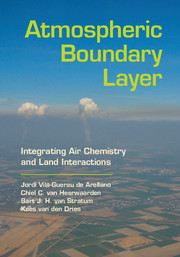Book contents
- Frontmatter
- Contents
- CLASS Software
- Preface
- Acknowledgments
- Part I The Land-Atmospheric Boundary Layer System
- Part II The Uncoupled System
- Part III The Coupled System
- Part IV Processes Related to Boundary Layer Clouds
- 14 Cloud-Topped Boundary Layer: Stratocumulus
- 15 The Partially Cloud-Topped Boundary Layer: Shallow Cumulus
- Part V User's Guide: CLASS Modules and Variables
- Appendices
- Bibliography
- Index
14 - Cloud-Topped Boundary Layer: Stratocumulus
from Part IV - Processes Related to Boundary Layer Clouds
Published online by Cambridge University Press: 05 July 2015
- Frontmatter
- Contents
- CLASS Software
- Preface
- Acknowledgments
- Part I The Land-Atmospheric Boundary Layer System
- Part II The Uncoupled System
- Part III The Coupled System
- Part IV Processes Related to Boundary Layer Clouds
- 14 Cloud-Topped Boundary Layer: Stratocumulus
- 15 The Partially Cloud-Topped Boundary Layer: Shallow Cumulus
- Part V User's Guide: CLASS Modules and Variables
- Appendices
- Bibliography
- Index
Summary
The Influence of Longwave Radiative Cooling: Dry Stratocumulus
Under clear sky conditions, the surface and entrainment turbulent fluxes are the ones introducing heat in the boundary layer and consequently driving the CBL growth and the thermodynamic variability. The presence of clouds introduces two new processes that influence the potential temperature budget: the divergence of longwave radiation at the top of the CBL and the water phase changes. In this chapter we study the first. The radiative emission or absorption by clouds has a strong influence on the boundary layer development since it is an additional cooling contribution to the potential temperature budget within the convective boundary layer. In this chapter, we will mainly focus on processes related to the stratocumulus formed above marine boundary layers (MBL). As such, the chapter can serve to introduce some of the relevant characteristics of the MBL. However, stratocumulus are also formed and present in ABL over land. In that respect, understanding the role of the divergence of longwave radiation driven by stratocumulus is also important in the development of convective boundary layers over land.
To study the effect of the radiative term, we focus on an important boundary layer cloud: stratocumulus. We will assume that these clouds are forming a deck with a large horizontal extension, that is, total overcast. To provide a first impression of the spatial structure of stratocumulus, Figure 14.1 shows a cross section of the fluctuation of specific moisture qt including the streamlines (left panel) with the half hour average of the specific moisture and the liquid water content ql (see Box 15.1) (see right panel). The cloud base is above 400 m and the cloud top at 800 m. The three-dimensional calculations of the state variables are made using the large-eddy simulation technique, and the numerical experiment is based on observations taken on the West Coast of California during the DYCOMS-II field experiment (Stevens et al., 2002).
- Type
- Chapter
- Information
- Atmospheric Boundary LayerIntegrating Air Chemistry and Land Interactions, pp. 179 - 189Publisher: Cambridge University PressPrint publication year: 2015



